-
PDF
- Split View
-
Views
-
Cite
Cite
Jens Przybilla, Ulrich Wegler, Michael Korn, Estimation of crustal scattering parameters with elastic radiative transfer theory, Geophysical Journal International, Volume 178, Issue 2, August 2009, Pages 1105–1111, https://doi.org/10.1111/j.1365-246X.2009.04204.x
Close - Share Icon Share
Summary
We present results of Monte Carlo simulations of elastic radiative transfer theory, especially in the range of strong forward scattering. Simulations were done for several types of continuous random media in a full space model. We show that fluctuation strength and correlation length are not resolvable in the strong forward scattering regime, but combinations of these parameters related to the transport mean free path (TMFP) can be obtained. From the frequency dependence of the TMFP we also obtain the type of the random medium. As an example, we invert local data from a crustal event for scattering parameters and show which parameters are resolvable in the strong forward scattering regime.
1 Introduction
For modelling of elastic wave energy propagation through the Earth's crust, radiative transfer theory (RTT) can be used. RTT describes the propagation of wave energy in scattering random media. Phase information is neglected, and it is assumed that wave energy is incoherent. In applications to real data, squared seismogram envelopes, which are proportional to the energy density of waves, are usually considered.
Originally, RTT was introduced to describe the transport of light through atmospheres (e.g. Chandrasekhar 1960). RTT is a so-called ladder approximation of the Bethe—Salpeter equation. This approximation works well if (1) wavelengths are comparable to correlation length, (2) fluctuations of the inhomogeneities are weak and (3) macroscopic features of the propagation medium are large compared with the wavelength (high frequency approximation; Papanicolaou et al. 1996).
In seismology, RTT was mostly used in the approximation of isotropic acoustic scattering to separate intrinsic and scattering attenuation (e.g. Hoshiba et al. 1991; Sens-Schönfelder & Wegler 2006). Anisotropic acoustic scattering approximation (e.g. Gusev & Abubakirov 1987, 1996; Wegler et al. 2006) is more realistic than isotropic scattering because envelope broadening can be modelled. So far, most applications are based on acoustic RTT and rely on the fact that due to conversion scattering, S-waves rapidly become dominant in the coda part of the seismogram (Aki 1992).
In elastic RTT, P- and S-wave modes are included and mode conversion is taken into account (e.g. Zeng 1993; Sato 1994; Margerin et al. 2000; Margerin & Nolet 2003; Shearer & Earle 2004; Przybilla & Korn 2008). With anisotropic RTT, a good agreement between finite difference solutions of wave equations and numerical solutions of radiative transfer equation is achieved. This has been shown for the acoustic RTT (Wegler et al. 2006) and also for the elastic RTT (Przybilla et al. 2006; Przybilla & Korn 2008).
The most recent development in seismic scattering theory is the introduction of conversion scattering between body and Rayleigh waves in the single scattering approximation (Maeda et al. 2008).
In this paper, we present the first systematic application of elastic RTT to invert scattering parameters of the Earth's crust. We find that for crustal scattering, the resolvable parameter is the transport mean free path (TMFP). We demonstrate that only a certain parameter combination of fluctuation strength ɛ and correlation length a is resolvable, depending on the type of autocorrelation function of the random medium. Finally, we show results of an inversion of scattering parameters from seismograms of a local earthquake in Norway.
2 Random Media




3 Radiative Transfer Theory
The coupled elastic radiative transfer equation is an integro-differential equation and is solved numerically by Monte Carlo simulations. In a Monte Carlo simulation, wave energy is represented by particles. Each particle is a bin of wave energy. Many particles yield the energy field of the wave. Particles start at the source and propagate through the medium with P- or S -wave velocity, according to ray theory. When scattering occurs, the particle changes its propagation direction and may convert from P to S, and vice versa. When particles pass a small spherical shell volume around the source, they will be counted. By averaging many particles (∼106 to ∼108), the energy density per time and volume is simulated. A full description of the Monte Carlo algorithm for the elastic 3-D case is given in Przybilla & Korn (2008).
3.1 Born scattering coefficients

 . Scattering coefficients depend on the power spectral density P of the random medium and scattering pattern X, for example,
. Scattering coefficients depend on the power spectral density P of the random medium and scattering pattern X, for example, 


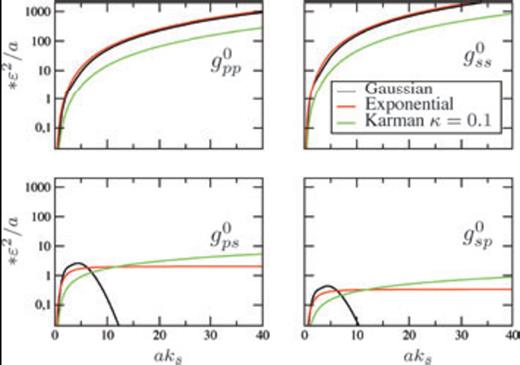
Dimensionless total elastic scattering coefficients for different random media. For a Gaussian autocorrelation function, the conversion scattering coefficients vanish in the case of strong forward scattering. That means P and S waves propagate separately without conversion between these modes.








3.2 Monte Carlo simulations for strong forward scattering
Now we study Monte Carlo simulations in the strong forward scattering regime aks ≫ 1, as apparently high frequency seismic waves seem to be mainly in strong forward scattering regime, because broadening of seismogram envelopes is often observed (e.g. Sato 1989; Saito et al. 2002). In Fig. 3, Monte Carlo simulations for different random media types and two values of aks are shown. TMFP is lst = 100 km in all simulations. As all terms in eq. (11) have the functional form like eq. (7), we can numerically determine a value of ɛ2/a for fixed aks and lst. This value is then used in the Monte Carlo simulations. Envelopes at three radial distances r = 0.5 lst, lst and 1.5 lst are plotted. In all graphs, the first peak is the P-wave onset and the second is the S-wave onset. Behind these peaks, codas appear.

Monte Carlo simulations for two values of aks in three different random media (columns) and for three different distances (rows). Simulations are done with the same value of TMFP of lst = 100 km. Differences between envelopes for different aks are clear in the Gaussian medium but very small in the case of other media.
In the Gaussian medium, there is strong difference in the P coda between aks = 8 and aks = 16. The conversion coefficients become very small in the Gaussian medium (Fig. 1). So, the sagged P coda for aks = 8 goes to an exponential like decreasing P coda for aks = 16. It follows that P and S waves propagate independent of each other, and we obtain a sharp transition between P coda and S-wave onset. This sharp transition remains for higher values of aks > 16. The envelope after S-wave onset remains similar for both values of aks.
In the exponential medium, we find the biggest difference between both simulations in S coda for distances smaller than TMFP. Here we have an influence of conversion scattering in the strong forward scattering regime too.
In von Karman medium with κ = 0.1, there is no clear difference visible. There are only small differences between the simulations for both values of aks in exponential and von Karman medium. This means that in the case of strong forward scattering, the envelope shape in a random medium for a distance r mainly depends on the TMFP.
Typical for envelope shapes in the strong forward scattering regime is envelope broadening for waves that are mainly forward scattered (near P- and S-wave onset) and a sagged S coda that is clearly visible in the Gaussian medium for distances smaller than TMFP. This sag of the S coda comes from the scattering nearly in propagation direction of waves. In summary, we can say that in the strong forward scattering regime, the dependence of envelopes on parameter aks is weak and the shape of envelopes mainly depends on TMFP. Therefore, in the strong forward scattering regime, we expect that only TMFP can be inverted from real data, whereas parameter aks is difficult or impossible to resolve.
4 Data Example
As a data example, we use the of 2004 April 7 ML = 3.5 Flisa earthquake, UMT 08:53:20.0. It occurred near the NORSAR array in southern Norway (Fig. 4) at 22.5 km depth (Schweitzer 2005). Therefore, we expect that, mainly, body waves are generated. The hypocentral distances are between 50 and 100 km. For this distance range, the influence of Moho reflections is not so strong compared with larger distances. So, a simple full space model is a reasonable approximation.
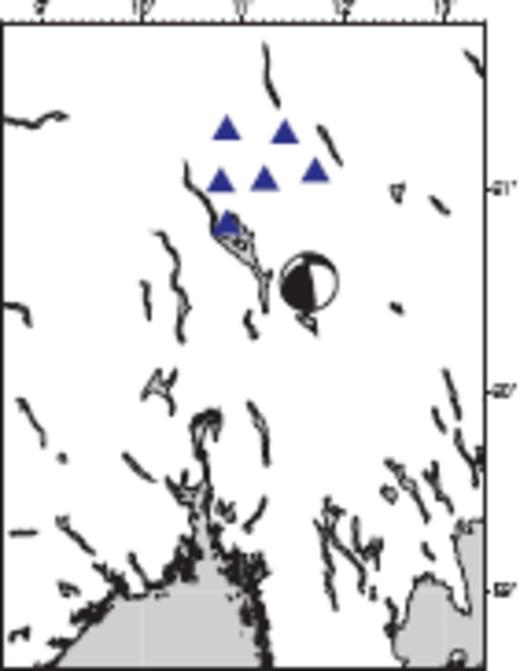
Location of the Flisa earthquake and the six used stations of the NORSAR array.
4.1 Data processing
Three-component broad-band data of six stations were processed. We used Butterworth bandpass filters of order 2, with centre frequencies of fc = 2, 4, 6, 8 and 10 Hz, with a bandwidth of 2 Hz. After filtering, squared envelopes of each component are computed, and all three components are stacked to obtain data envelopes that can be compared with mean squared envelopes of Monte Carlo simulations. All envelopes are normalized by average energy in a time window of t = 275–300 s. With this normalization, we minimize the influence of site effects for different stations.
4.2 Forward modelling

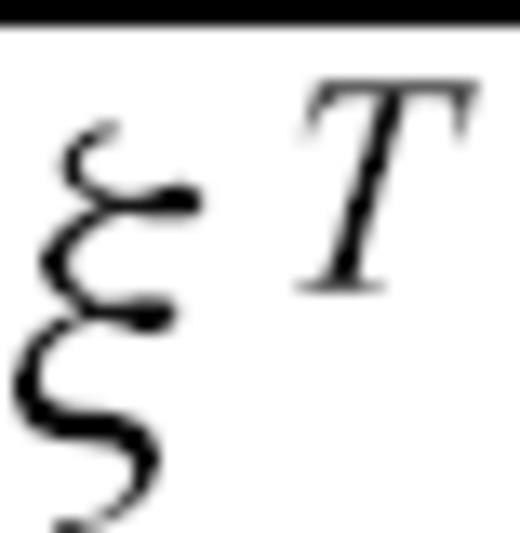 is the time average of ξ(t′), 〈ξ〉 is the ensemble average and
is the time average of ξ(t′), 〈ξ〉 is the ensemble average and 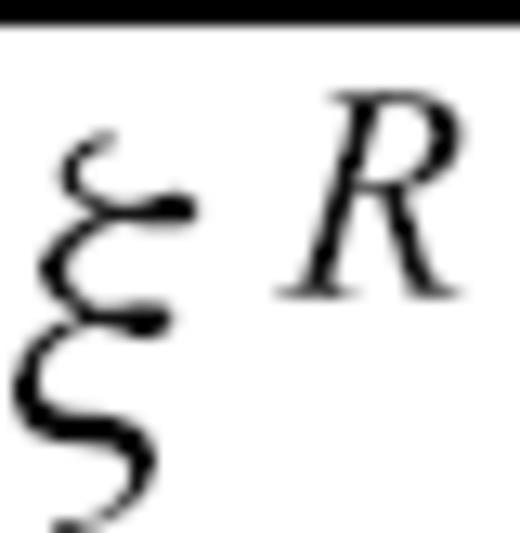 is the spatial average. Here we use the squared seismogram envelopes as an approximation for the stochastic field ξ. We obtain spatial averaging due to the use of receivers in different distances and angular directions from the source, although the azimuthal range is limited to about 60°.
is the spatial average. Here we use the squared seismogram envelopes as an approximation for the stochastic field ξ. We obtain spatial averaging due to the use of receivers in different distances and angular directions from the source, although the azimuthal range is limited to about 60°.The time averaging  is realized by using time windows of length T = 7 s with 50 per cent overlap, which is large enough to build an average but small enough to see differences between data and simulation envelopes near the P- and S-wave onsets. We compare simulated and data envelopes from P-wave onset up to a lapse time of 300 s, limited by a minimum signal to noise ratio of 4, estimated between S coda and envelope before P-wave onset, in a time window of 7 s.
is realized by using time windows of length T = 7 s with 50 per cent overlap, which is large enough to build an average but small enough to see differences between data and simulation envelopes near the P- and S-wave onsets. We compare simulated and data envelopes from P-wave onset up to a lapse time of 300 s, limited by a minimum signal to noise ratio of 4, estimated between S coda and envelope before P-wave onset, in a time window of 7 s.
Fig. 5 shows data envelopes for three frequencies at one station (NC3). The envelope in the 2 Hz band has a strongly sagged S envelope, but envelopes at higher frequencies show an almost exponential decrease. This sagged S envelope shows that waves must be in a strong forward scattering regime at distances shorter than TMFP (see Fig. 3). In Fig. 3, we see a sagged S envelope, especially for the distance r = 0.5lst. In the Monte Carlo simulations, for computational reasons, we use an isotropic radiating source with an energy ratio of Ws0/p0 = 23.5, corresponding to a DC source in a Poisson solid (Sato & Fehler 1998). The observed DC has an orientation as shown in Fig. 4. If we compare the time integrals of data envelopes near the P- and S-wave onsets, we get a ratio of Ws0/p0≈ 20, near the theoretical ratio.
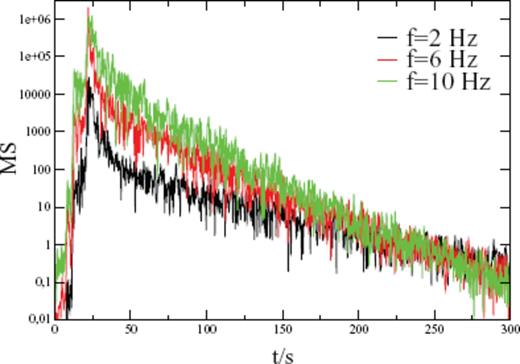
Data envelopes of station NC3 of the NORSAR array in three frequency bands normalized to the time average between t = 275 and 300 s. Envelope for fc = 2 Hz shows a clearly sagged S coda compared to the almost exponentially decreasing envelopes at higher frequencies.


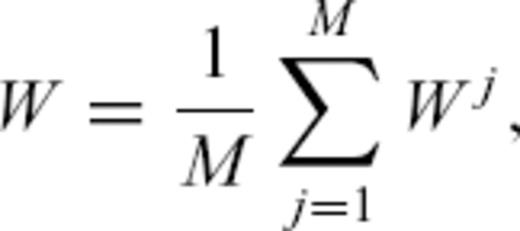
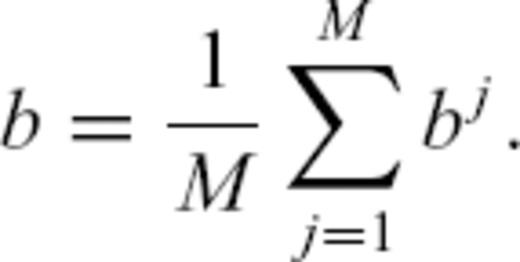

To estimate κ of the von Karman medium, we took the following approach to avoid a computationally expensive grid search on κ: in a preliminary step, we performed an inversion for the S coda part of the envelopes with an analytical approximation by Paasschens (1997), which is based on acoustic isotropic scattering. The same inversion strategy as described above has been used. As a result, a frequency dependence of TMFP as lt∝f−0.6 was obtained, yielding κ = 0.2 (eq. 16). This value of κ is then used as a fixed parameter in the full inversion based on Monte Carlo simulations of elastic RTT. Additional support for this choice comes from Flatté. & Wu (1988), who showed that neither a Gaussian nor an exponential random medium is a good estimation for the crustal structure under NORSAR.
In Fig. 6 and 7, best fits from the full elastic inversion are shown for frequencies 2 and 10 Hz. The influence of source radiation pattern can be seen in the 2-Hz-frequency band. There is a minimum in P-energy radiation at station NB2 and NC3. For 10 Hz, the influence of source radiation pattern is not visible anymore.
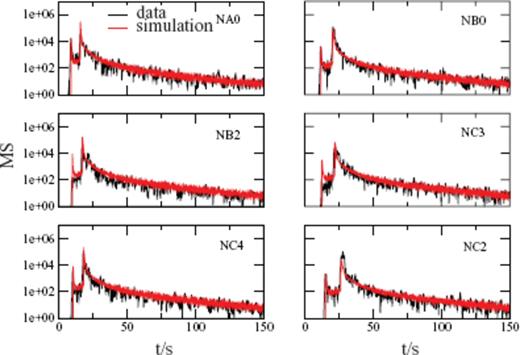
The six panels show the best Monte Carlo fits to data in the fc = 2 Hz frequency range. All six (NA0, NB2, NC4, NB0, NC1, NC2) stations are plotted. Distance is increasing from top to bottom and from left- to right-hand side.
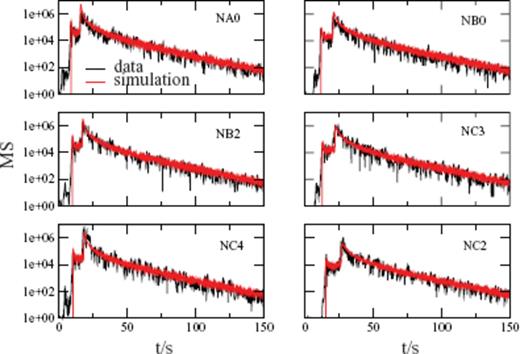
Misfit functions e for different values of aks are shown in Fig. 8, plotted against the parameter value ɛ2/a0.4. In all frequency bands, we obtain nearly the same value for ɛ2/a0.4 = 2 × 10−3 km−0.4 at the minimum of the misfit function e. The minimum is found for the maximum value of aks = 32, but the difference is very little compared with aks = 16 and aks = 8. This means that the correlation length a of the crust has a large value, so that we find the minimum of the misfit function at the maximum value of aks = 32. Higher values of aks cannot be simulated with the Monte Carlo method because of long simulation times. However, higher values of aks are not resolvable as seen in Fig. 3, where only small differences between the envelopes at aks = 8 and aks = 16 occur, especially in the von Karman medium. This means that if waves are in the strong forward scattering regime, the influence of parameter aks on the envelope shape is very little, especially in distance range greater or equal to the TMFP. In Fig. 9, the same misfit functions are plotted as in Fig. 8 but against the TMFP of S waves. The resolution of the TMFP gets better for large values of aks. Especially in the high frequency regime, the minimum of the misfit function is sharp. This means that the resolvability of the TMFP corresponds with the resolvability of ɛ2/a0.4.
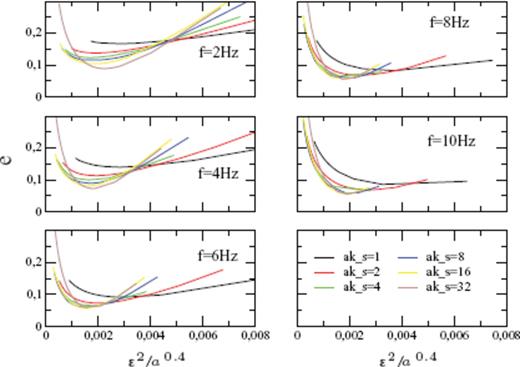
Misfit functions e for different values of aks in all used frequency bands against the parameter combination ɛ2/a0.4.
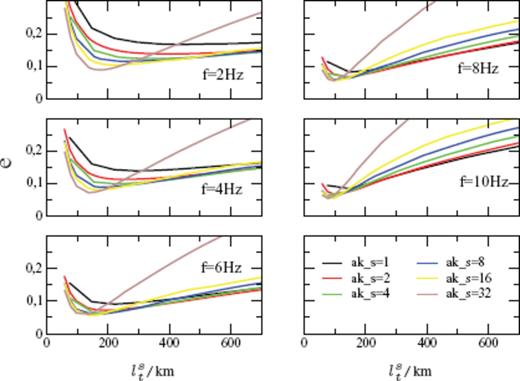
The same misfit functions e as in Fig. 8, but here against the transport mean free path lst of S waves.



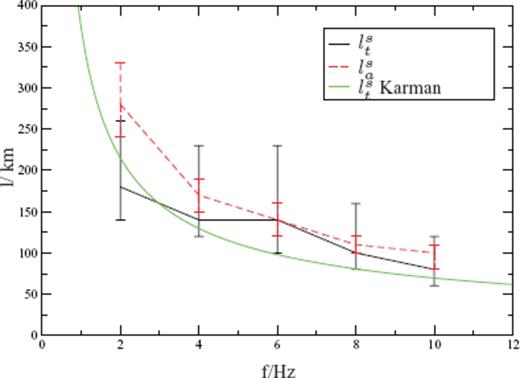
Estimated transport mean free paths lst and absorption mean free path lsa for the Norwegian data example. For both, we find a decrease with frequency. Error bars are estimated with the F-test with 95 per cent confidence interval. The green curve shows the theoretical value for lst in a von Karman medium with κ = 0.2 calculated from eq. (11) with a = 4 km−1 and ɛ = 0.059 per cent.
5 Discussion And Conclusions
Monte Carlo simulations of wave energy transport through scattering media are a useful tool to compare theoretical seismogram envelopes with envelopes of seismic data. In contrast to acoustic simulations, elastic Monte Carlo simulations allow the comparison of envelopes from first P-wave onset until the late coda. This means that we can use the P coda together with the S coda.
From our Monte Carlo simulations and in the comparison with data, we find that in the strong forward scattering regime, the dependence of envelopes from parameter aks is weak. This implies that only TMFP is the parameter of the random medium that is resolvable (Figs 3 and 9). The importance of the TMFP as a key parameter for pulse broadening and coda envelopes was previously suggested in Gusev & Abubakirov (1996) for acoustic waves. Here we can resolve a parameter combination of a and ɛ that depends on the type of random medium and can be calculated analytically for the acoustic TMFP. This parameter combination is the same for the elastic TMFP. For our data example, we found that a von Karman medium with κ = 0.2 fits the data well and is a good model for small-scale heterogeneity of the Norwegian crust near the NORSAR array. It was found in Flatté. & Wu (1988) that in the case of a single scattering layer model a von Karman medium with κ = 0.33 fits the data better than a Gaussian or an exponential medium below the NORSAR array. That result is close to our finding.
Our data example also shows that waves with frequencies greater than 1 Hz are in the range of strong forward scattering. In strong forward scattering regime the Markov approximation can be used to simulate the broadening of envelopes. It is valid for the first part of a seismogram only. The coda part cannot calculated. Przybilla & Korn (2008) showed that the Markov approximation of elastic waves (Sato 2007) and Monte Carlo simulations agree very well at the beginning of the P- and S-wave onsets. In Monte Carlo simulations, we have the possibility to simulate the pulse broadening and the coda part of envelopes simultaneously. That makes it easier to separate intrinsic absorption from scattering absorption in Monte Carlo simulations compared with the Markov approximation. The Markov approximation was used, for example, to compare seismograms of small high-frequency earthquakes at intermediate distances (Sato 1989). It was also used in Saito et al. (2002), where random inhomogeneity parameters in northeastern Honshu Japan were estimated as a von Karman medium with κ = 0.6 and ɛ2.2/a≈ 10−3.6 km−1.
In future work, the Monte Carlo algorithm will be expanded to more complicated geometries, for example, a scattering layer over homogeneous half-space. In such a model, there exists an exponential decay of the envelopes too. The reason for this is the leakage of energy from the crust into the mantle. Margerin et al. (1999) showed that this effect is small if the MFP is much larger than the crustal thickness. In our data example, we have seen that the TMFP is larger than the crustal thickness; and so, there is probably only a small effect of energy leakage into the mantle. Therefore, we think that for the distance range up to around 100 km from source, the full space model is a reasonable first approximation to estimate scattering parameters.
Acknowledgments
We thank the staff of the NORSAR Institute for providing data and for their friendly support. We also thank the Access to Research Infrastructure (ARI) programme for a very interesting short term stay at the NORSAR Institute. This work was supported by Deutsche Forschungsgemeinschaft (grants Ko1068/5-1,2, We 2713/2-1). Some parts of the computations were done at the John von Neumann computing centre Forschungszentrum Jülich. The authors are grateful for helpful comments to two anonymous reviewers.
References





